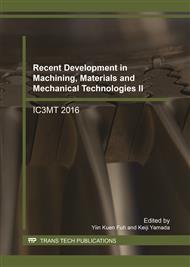p.3
p.9
p.15
p.21
p.27
p.33
p.39
p.46
p.52
Influence of Scratch Marks on Undeformed Chip Thickness in Ultra-Precision Cutting of Al-Mg Alloys
Abstract:
Recently, high efficiency and performance have become necessary attributes of information equipment such as laser printers. Thus, demand has increased for optical scanning parts that reduce optical aberration, scatter, and diffraction are required in laser printers. Polygon mirrors are manufactured by polishing a plating or glassy material to a mirror finish. In this study, we shortened the manufacturing process to improve the productivity and ultra-precision cutting technology of polygon mirrors made of aluminum. Thus, we had to reduce the geometric surface roughness achieved by mirror-cutting Al-Mg alloy and remove tear-out and scratch marks that occur during the cutting process. We investigated the cutting edge shape by using a straight diamond tool to decrease the surface defects produced during the ultra-precision cutting of Al-Mg alloy. We examined the mechanism for the occurrence of scratch marks and a method to reduce them. First, we measured the shape of the scratch marks and the cross-section with a scanning electron microscope. We found the tool collides with crystallization to produce small pieces, which then cause scratch marks. We developed a triple-facet tool with a double-facet at the end cutting edge to remove scratch marks and investigated the influence of surface defects. We clarified that using the triple-facet for a tool setting angle of 0° to 0.04° could achieve a good-quality machined surface without tear-out and scratch marks. In addition, the undeformed chip thickness was less than 80 nm
Info:
Periodical:
Pages:
27-32
Citation:
Online since:
August 2017
Price:
Сopyright:
© 2017 Trans Tech Publications Ltd. All Rights Reserved
Share:
Citation:


